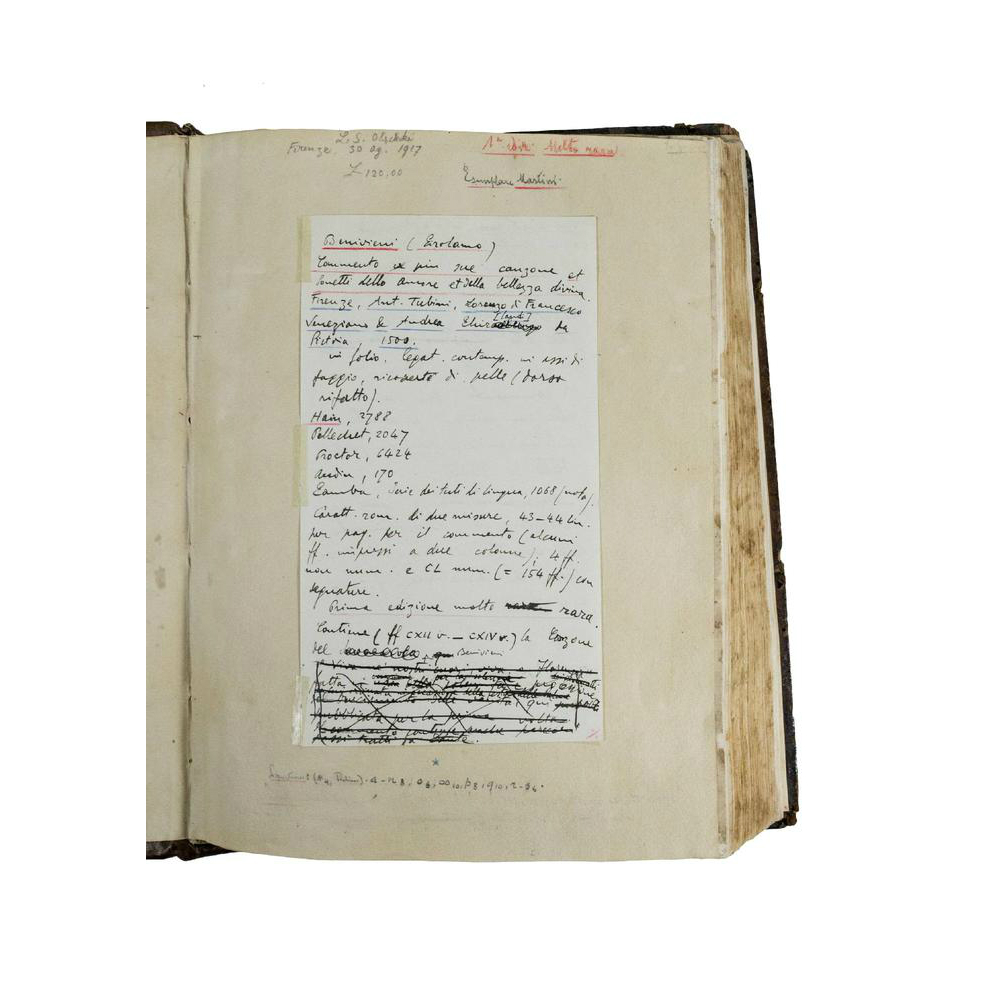Benivieni, Girolamo (1453-1542). Canzoni e sonetti... Florence, Antonio Tubini, Laurentius (Francisci) de Alopa, Venetus and Andrea Ghirlandi, 7 September 1500.




Benivieni, Girolamo (1453-1542). Canzoni e sonetti... Florence, Antonio Tubini, Laurentius (Francisci) de Alopa, Venetus and Andrea Ghirlandi, 7 September 1500.
Benivieni, Girolamo (1453-1542).
Canzoni e sonetti dell’amore e della bellezza divina, con commento.
Florence, Antonio Tubini, Laurentius (Francisci) de Alopa, Venetus and Andrea Ghirlandi, 7 September 1500.
Bonfire of the Vanities
Benivieni, Girolamo (1453-1542).
Canzoni e sonetti dell’amore e della bellezza divina, con commento. Florence, Antonio Tubini, Laurentius (Francisci) de Alopa, Venetus and Andrea Ghirlandi, 7 September 1500.
Chancery folio (281x212 mm). Collation: [π]4, a-n8, o6, oo10, p8, q10, r-s6. [4], CL leaves. Text in one column, surrounded by commentary, 44-45 lines. Fols. r1-s6 in two columns, shoulder notes. Type 2:107R (text), 1:86R (commentary). Blank spaces for capitals, with printed guide letters. Contemporary blind-tooled brown calf, over wooden boards. Covers within three fillets, and filled with diagonal blind lines. Spine early rebacked, renewed clasps and flyleaves, upper headcap slightly damaged. A very large copy, a few stains and wormholes towards the end, repairs to the corner of the first two leaves. Interesting contemporary marginalia throughout.
Provenance: the Certosa at Casotto, near Cuneo, in Piedmont (ownership inscription on the title-page, 'Cartusia Casularum mihi a M. de ducibus donato'; in the same hand the annotations on the margins); 'Jo. iac. salomonius' (ownership inscription on the title-page, with five Latin diptychs in praise of Benivieni's poems written in the same hand); Leo S. Olschki (1861-1940; pencilled note on the recto of the front flyleaf, 'L. S. Olschki. Firenze, 30 Ag. 1917, £120.00'; see Monumenta typographica. Cat. LIII, Florence 1903, no. 1805, and Choix de livres anciens, rares et curieux, I, Florence 1907, no. 1965, 'Ais de bois rec. de veau, dos refait'); Giuseppe Martini (1870-1944; his collation and bibliographical notes on the front pastedown).
First edition, in first issue, of Benivieni's Neoplatonic verse summary of the Libro dello amore, a commentary on Plato's Symposium that was strongly influenced by the Ficinian theory of love. The work is famous for containing the first eye-witness account ever printed of Savonarola's famous Bonfire of the Vanities, held in the Piazza della Signoria during the Carnival on 7 February 1497.
Benivieni, a prolific versifier of conventionally Petrarchian love poems, was a close friend of both Marsilio Ficino (1433-1499) and Giovanni Francesco Pico (1469-1533), nephew of Giovanni Pico della Mirandola whose only work in Italian was a prose commentary on Benivieni's Canzone, at the time still unpublished but paraphrased by the latter, and inserted into the present edition. The volume was printed by Tubini, Alopa, and Ghirlandi during their short partnership in 1499-1500, and the publication is one of only three stating their names. The preliminary leaves contain Benivieni's dedicatory epistle to Giovanni Francesco Pico, while his dedication to Niccolo Vicecomite da Coreggio is printed on fol. r5v.
The Florentine humanists Benivieni, Ficino, and Pico della Mirandola were all contemporaries of Girolamo Savonarola (1452-1498) and ardent admirers and supporters of his reform ideas, as were the three printers Tubini, Alopa, and Ghirlandi. It was in this cultural and social context that the present edition appeared. In 1496, Benivieni translated Savonarola's De simplicitate, and one of the most remarkable inclusions of this collection is the first printed eye-witness account of the famous 'bruciamento' at the bequest of Savonarola, the Bonfire of the Vanities held in the Piazza della Signoria during the Carnival on 7 February 1497. This Canzone (fols. oo6r-oo7r) offers a detailed list of the 'lascivious, vain and detestable objects' that were thrown on the fire, including paintings, musical instruments, feminine ornaments, dice, cards, and other such works of Satan.
The edition is known in two variants: the copy presented here belongs to the first issue with the colophon dated 7 September, and has the lines 24-25 of the table on fol. [π]3r.
H *2788; GW 3850; BMC VI, 693; IGI 1481; Goff B-328; Rhodes Firenze, 106; A. Jacobson Schutte, Printed Italian Vernacular Religious Books (1465-1550). A Finding List, Genève 1983, p. 72; R. Ridolfi, “Girolamo Benivieni e una sconosciuta revisione del suo Canzoniere”, La Bibliofilia, 66 (1964), pp. 49-62; R. Leporatti, “Canzone e Sonetti di Girolamo Benivieni fiorentino. Edizione critica”, Interpres, 27 (2008), pp. 144-298 (esp. pp. 156-161); A. Giaccaria, “I libri della Certosa di Casotto alla fine del Cinquecento”, R. Comba - G. Comino (eds.), Dal manoscritto al libro a stampa nel Piemonte sud-occidentale, pp. 169-199; Philobiblon, One Thousand Years of Bibliophily, no. 44.